“All butterflies must have a happy home” (Lionel G. Higgins (author of A Field Guide to the Butterflies of Britain & Europe) 1891-1985)
Today there is a heightened awareness of the dangers posed to the environment by human behaviour. The ways humans farm, travel, exploit fossil fuels and construct infrastructure are under scrutiny as global temperatures rise and polar ice shrinks. There is, it appears, scarcely a political party that does not express opinions (often vacuous virtue-signalling) on the state of the environment. Environmental causes make themselves known in our inboxes, twitter feeds, TV screens, digital and print publications. Academics have risen from obscurity to become prophets of environmental Armageddon. Teenage climate change activists have become household names.
The zeitgeist of the age is fear of an environmental meltdown. The Amazonian fires are a powerful metaphor for global warming and ecological catastrophe. European Union countries threatened to block a trade deal with four South American countries unless the Amazon fires are doused while those same European countries will encourage more rain forest removal because the production of beef and other food forms part of the deal. In the midst of all this noise, confusion and despair develop in many, fearful of the apparently inevitable nightmare of global ecological and biological collapse.
The solution offered here is small and anti-climactic given the global scale of the spoliation of Earth’s natural goodness. But it is real.
Look after your garden.
Make it a home for butterflies. This will automatically protect all wildlife residing in your domain. A network of unofficial nature reserves can be built offering connected safe habitats for you and your wildlife. Gardens can be created and actively managed for nature. This message has already been heard and heeded by some of you. Here’s what just some Butterfly Conservation Ireland members have done to create a happy home for butterflies.
Looking after butterflies, moths, bees, hoverflies and a range of other invertebrates does not require a large space. A cleverly designed typical suburban garden can work wonders for butterflies. Let us look at Michael Gray’s garden in Rathfarnham. Michael’s elegant planting creates a striking vista, very inviting for people and butterflies. He has curved his herbs and shrubs around a central gravelled area, abandoning a lawn altogether. This arrangement has a number of benefits. No mowing is one. A small lawn is unlikely to be of great value to butterflies and moths. The gravel plays its part too, helping to provide warmth around the plants, encouraging insects to linger while in cooler weather butterflies use the gravel to bask on.
The inducements offered are chiefly nectar resources. Buddleia, a butterfly’s delight is provided in three corners of the garden while Catmint, an important plant for bees edges onto the decorative gravel. Various other butterfly-friendly flowers edge the gravel too. Michael’s garden has so much nectar that some butterflies will stay there for days, drawing in the nectar needed for the next phase of their life’s journey.
Michael has not neglected larval foodplants. In the far right is a well-developed Alder Buckthorn tree, a small and rare native species that fits well. Holly Blue butterflies readily breed on the flowers and developing berries and fresh leaves while bees are obsessed with the flowers. Later, Robins will polish off the ripe berries. In the bottom left of the photograph, you will see nasturtiums, great for the caterpillars of the Large and Small White butterflies, while elsewhere his Borage, another great draw for bees, is used by his Painted Lady caterpillars. Michael also grows Common Bird’s-foot-trefoil, Kidney Vetch, Lady’s Smock and Common Sorrel which are all foodplants for butterflies. He even persuaded a neighbour to allow Common Ivy to grow up the wall (see wall to the left). The result? Holly Blue butterflies now breed on the plant!
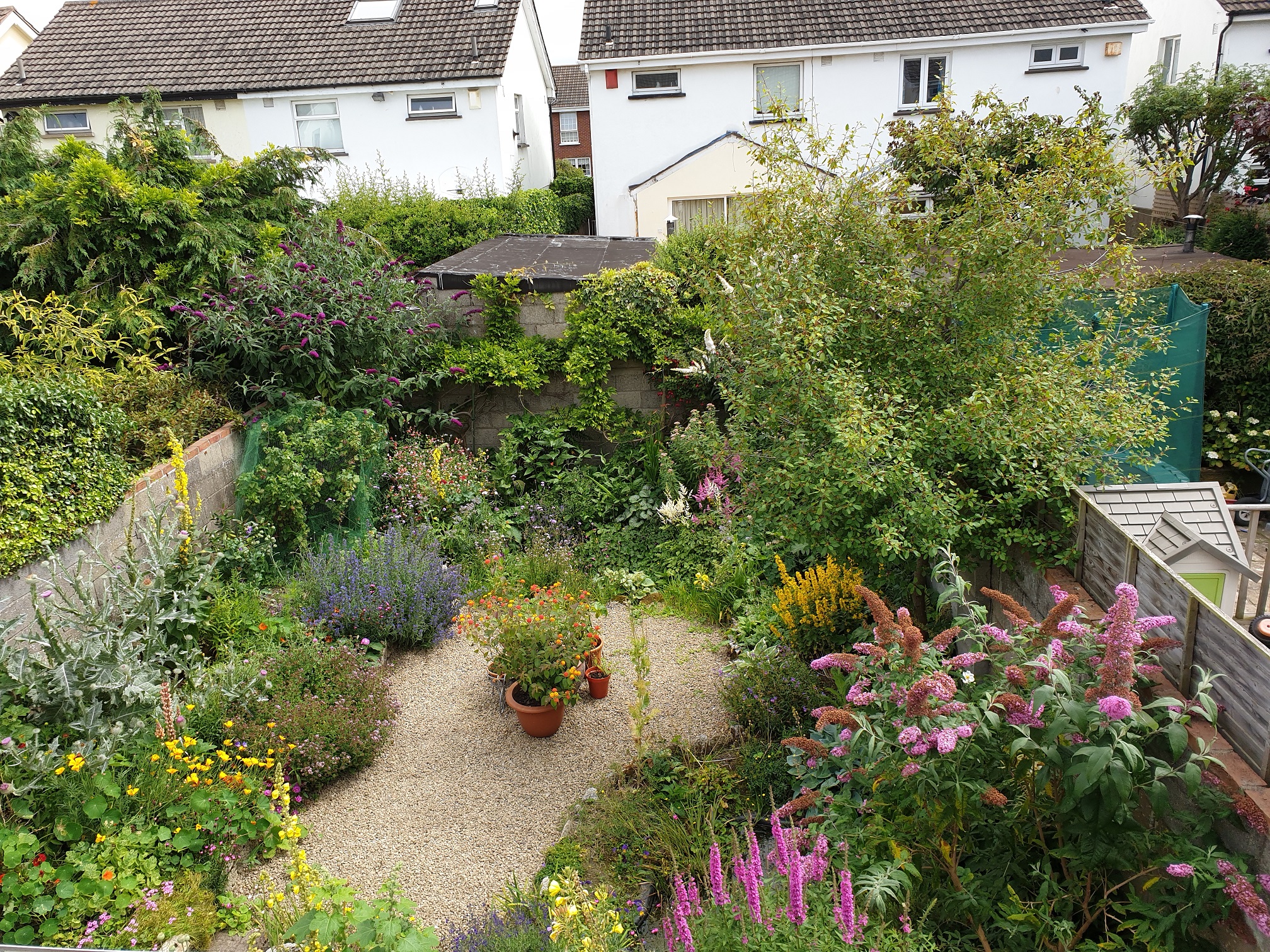
Some gardeners have the luxury and challenge, of a larger space. Marilyn Farrell, who lives in rural Kerry is looking after a large garden. Here, in her words, is what Marilyn and her husband have done.
“My husband and I bought our two-storey traditional farmhouse in 1996. It had been abandoned and was not liveable then. We also didn’t know until shortly before signing the contract that we got three small fields with the house! A dairy farmer neighbour was using the fields for his cows so we let him continue to do so.
When we moved here permanently in 2003 after the house had been rehabbed, I planned as a retired person to just garden the area around the house. However, I can’t seem to stop planting, so now, there is only one field left for cows!
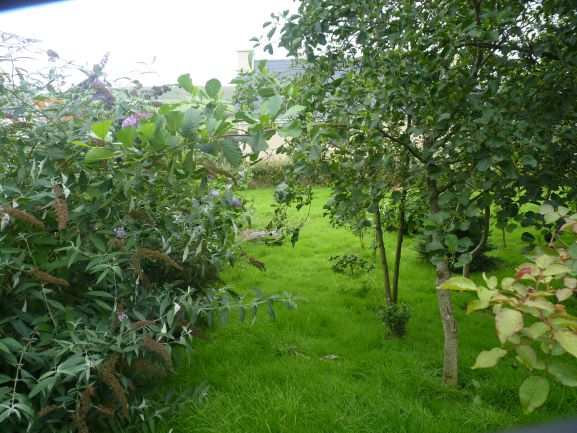
So now, without the use of chemicals, my husband and I have our own vegetables all summer, we have hedges everywhere as we are very near the ocean and the winds do howl, we have planted a mini-forest consisting of native trees (and have persuaded our sceptical neighbours to plant trees as well). I dug a small pond that produces many frogs each year, we have flowers year-round, many of which are wildflowers growing with the domestic ones, we are in the process of making a part of the forest field into a native wildflower meadow, and the entire property is bordered with wild, freely growing hedgerows full of nettle, blackberries dog roses, and other plants for butterfly larva. And the ”grassy” areas are more clover and wildflowers than grass.
Marilyn’s greenhouse border is especially eye-catching. The Sea Pinks Armeria maritima is a native plant and loved by bees, while Marilyn’s Buddleia and Ice Plant Sedum spectabile are very popular with butterflies.

Another interesting garden, one I have had the pleasure to visit is Lesley Whiteside’s near Mullingar in Westmeath. Lesley noticed an orchid on her front lawn so avoided mowing. Soon there were dozens, mainly Common Spotted Orchids but also Pyramidal Orchids and Common Twayblades. Orchids are sensitive, fussy plants that need very ‘clean’ soil. The soil must remain free of added chemicals if orchids are to survive.
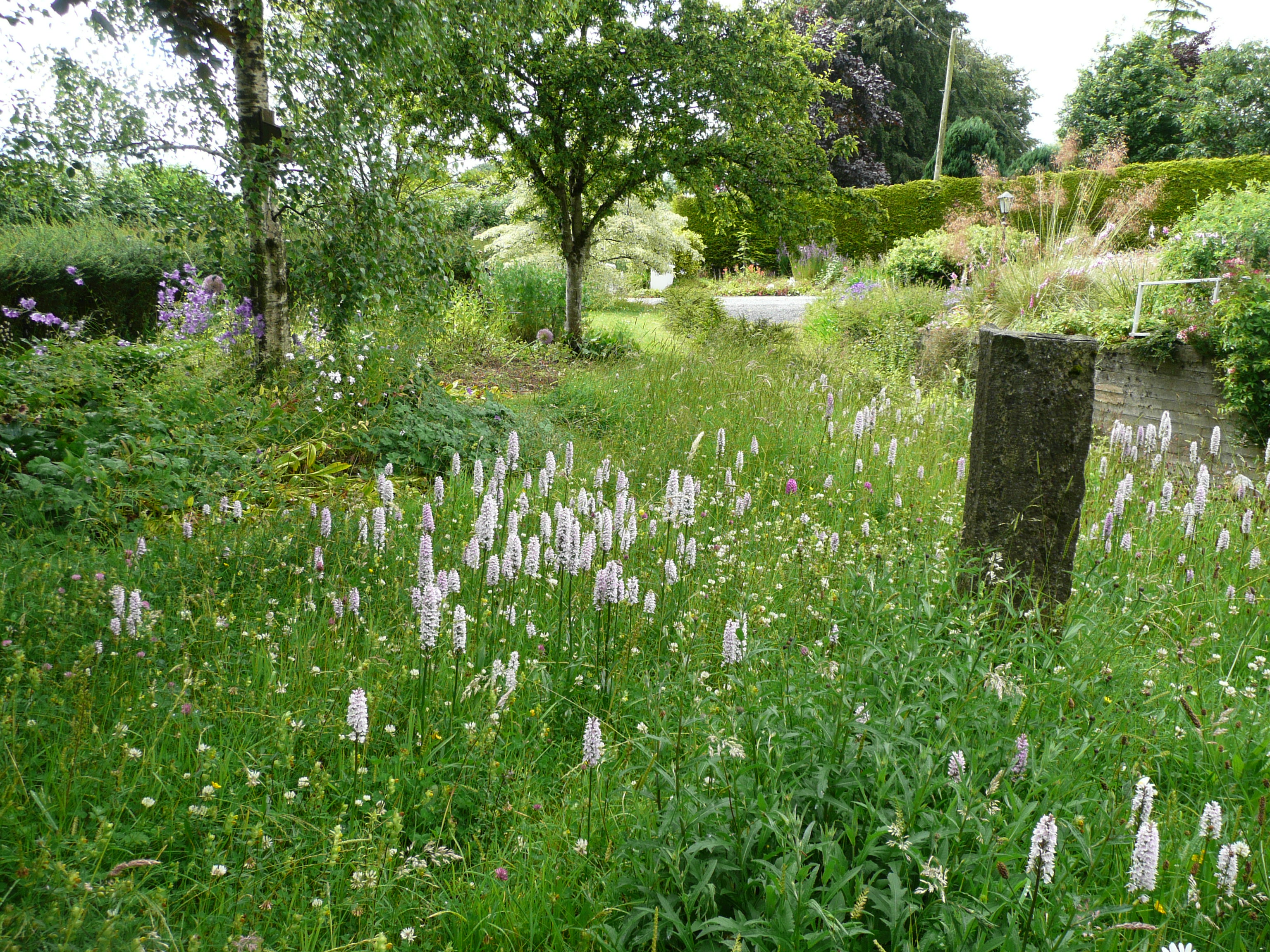
Here Lesley reports on her garden’s story
“My garden is almost an acre. When we moved in, there were Leylandii hedges on three sides, lawn, a border and three or four trees. The first autumn, I planted a native oak, birch, fruit trees and started a vegetable and soft fruit garden. Next, I took out the two hedges which belonged to me and began developing borders planted with shrubs, bulbs, grasses and herbaceous perennials closely related to native wildflowers, such as Achillea (related to Yarrow). Wanting to garden for biodiversity, I have provided plants all year round for pollinators, such as Sarcococca in winter, Pulmonaria in spring, Lavender and Marjoram in summer and Asters in autumn.
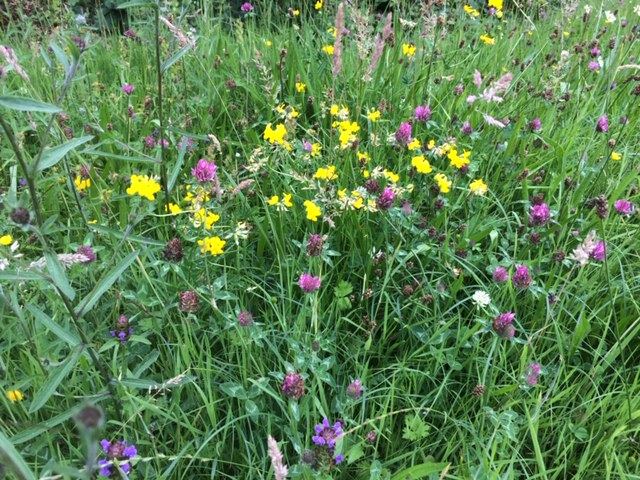
During our first summer, I noticed wild orchids popping up in the gravel and decided to allow the lawn to grow as a wild meadow, only cutting a strip around the outside and in strategic places along the way. Nothing has been added. It has been a great success, so each summer butterflies and moths visit an ever-growing variety of flowers and grasses. We trap moths from March to October and always bear in mind their particular needs. I added a wildlife pond two years ago. In August, Painted Lady, Peacock and Red Admiral butterflies flit between Marjoram, Monarda and Eupatorium as well as the Common Knapweed in the meadow. Willowherbs have only recently begun to spread locally, so having Fuchsia in the garden supports the spectacular Elephant Hawk-moth which is appropriately pink. Likewise, there isn’t an abundance of Honeysuckle locally, so having some in the garden attracts the Ypsolopha dentella moth”.
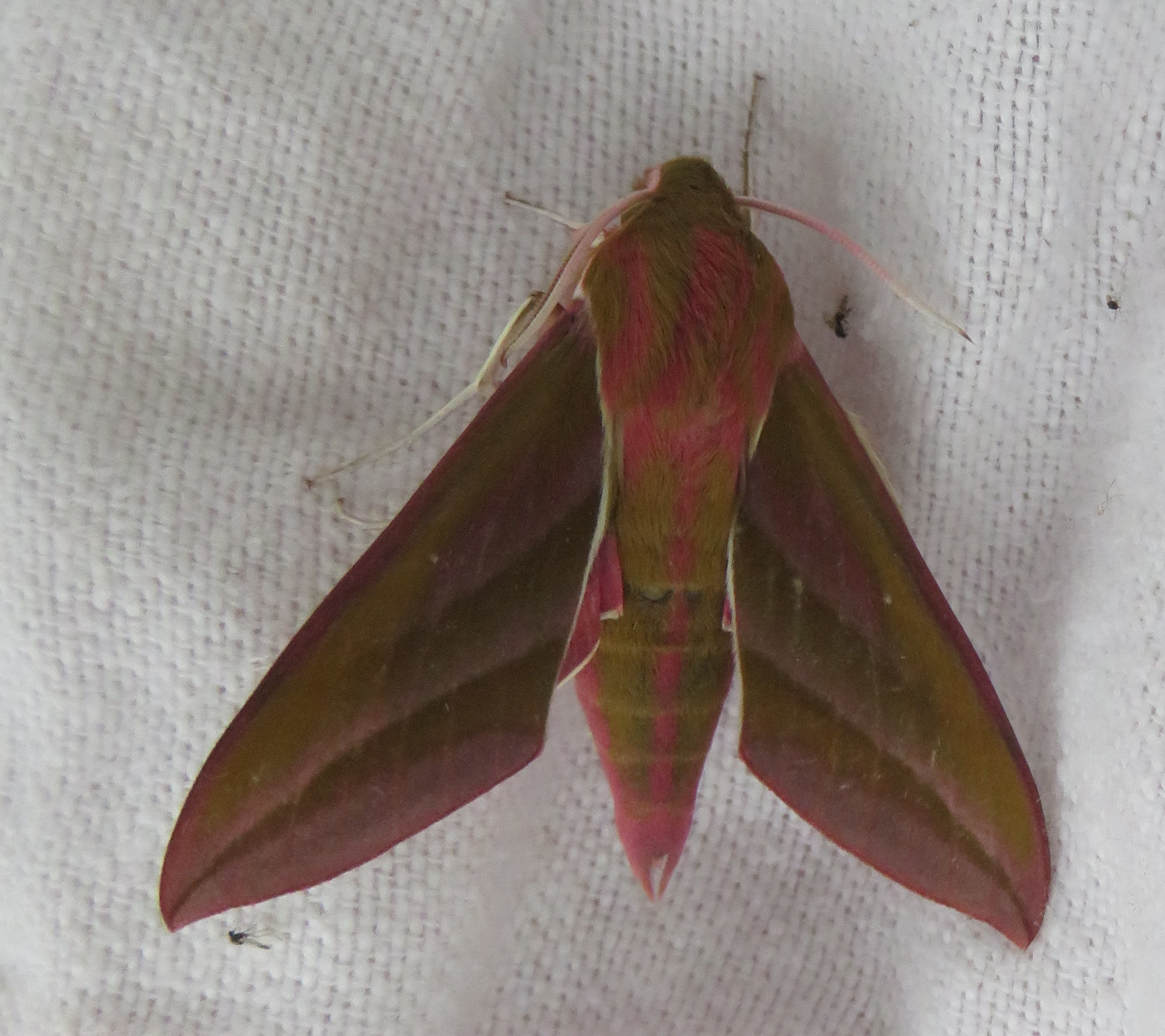
A work in progress, Lesley’s garden will draw in more species as it matures.
Another Westmeath garden is Jennifer Strevens’ large and fascinating garden a short stroll from the eastern shore of Lough Ree. I visited on a lovely sunny day in late August and could easily have stayed all day. Jennifer has about two acres of assorted borders of flowers, lots of shrubs and ornamental trees, a kitchen garden, greenhouse and tunnel and an orchard of about 80 assorted fruit trees and a deciduous forestry plantation of 60 hectares. Jennifer spoke to me about the land: “The property runs down to Lough Ree and I have about a kilometre of lakeshore. There are many wildflowers and no fertilisers or sprays whatsoever have been used on any part of the property in 20 years since we sold our dairy herd and planted a largely deciduous plantation. Apart from butterflies, there is a wealth of other wildlife from Red Squirrels to Pine Martens, Badgers and lots of birds from Ravens to Herons, owls, Common Buzzards, harriers and even the occasional eagle! There are nine bat boxes and a very large and varied nursing colony of bats”.

The orchard is particularly interesting and valuable. The trees grow in a grassy meadow. Many are from Seed Savers, an organisation that seeks to preserve older varieties of fruit tree. There are a number of plum trees, apple trees, Medlar trees among others, including a Kiwi trained against a wall! The orchard has large nettle clumps growing in ideal places for breeding by Red Admiral, Painted Lady, Small Tortoiseshell, Comma and Peacock butterflies as well as Burnished Brass moths. The lush grasses are perfect for Speckled Wood, Meadow Brown and Ringlets. The garden was awash with Red Admiral, Peacock and Speckled Woods on the day of my visit-mostly taking juices from apple (Speckled Wood) and plum (Red Admiral and Peacock). I was delighted to see Brimstone in the garden-I never saw wild Brimstones in an Irish garden before! Small Copper, the two “cabbage whites” and Small Tortoiseshell were also present-the whites breeding on brassicas in Jennifer’s kitchen garden.

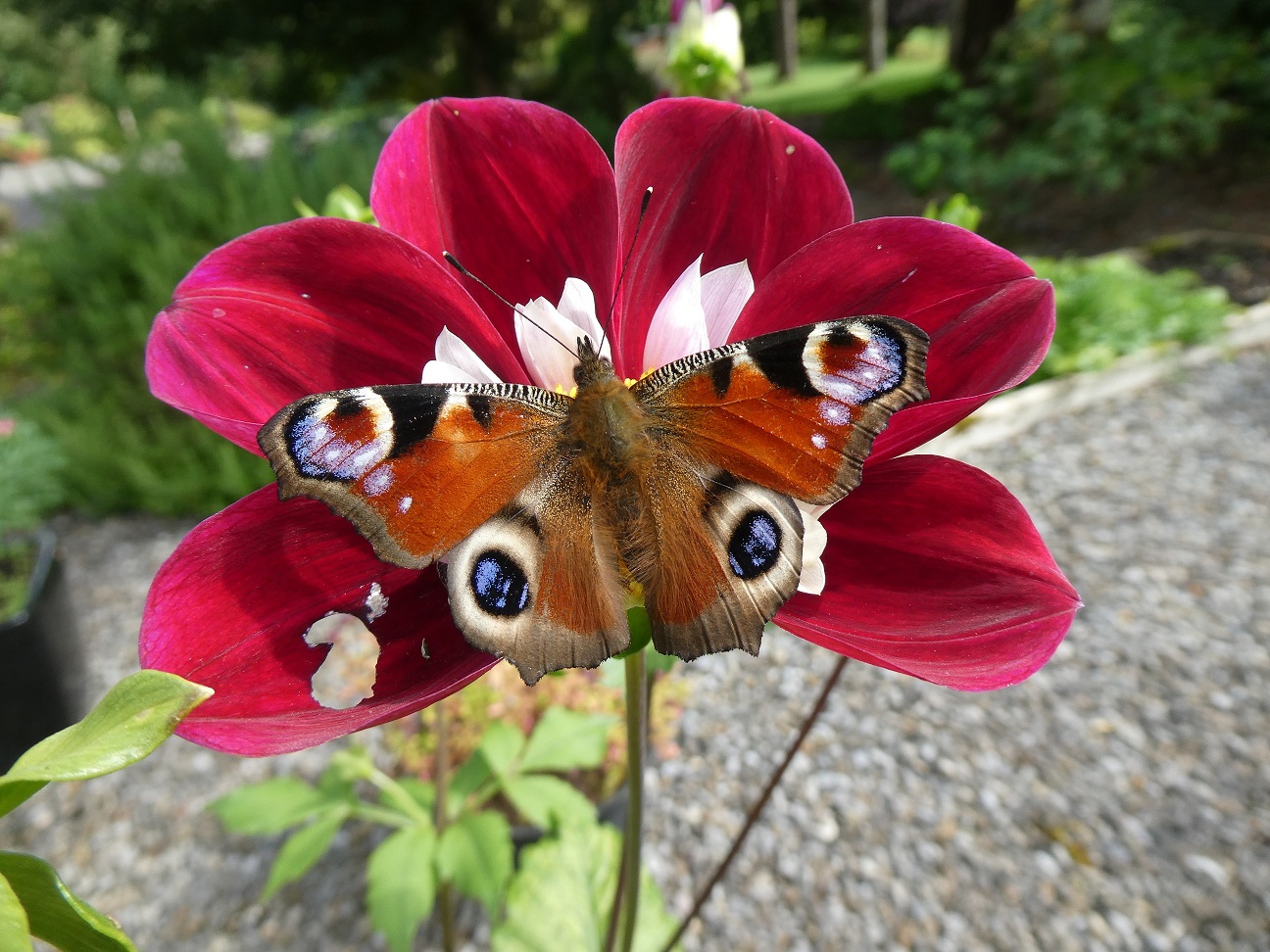
The land beyond the garden is wilder and mainly under native broadleaf tree cover. I thought Jennifer’s Sessile Oaks looked impressive-the elusive Purple Hairstreak might well be present in the lofty oak canopy! This area is not strictly part of the garden but is contiguous with it, blending easily with the garden around the house. But that part of the land is part of a wider story of managing a large area for nature which, wonderfully, is what Jennifer does.
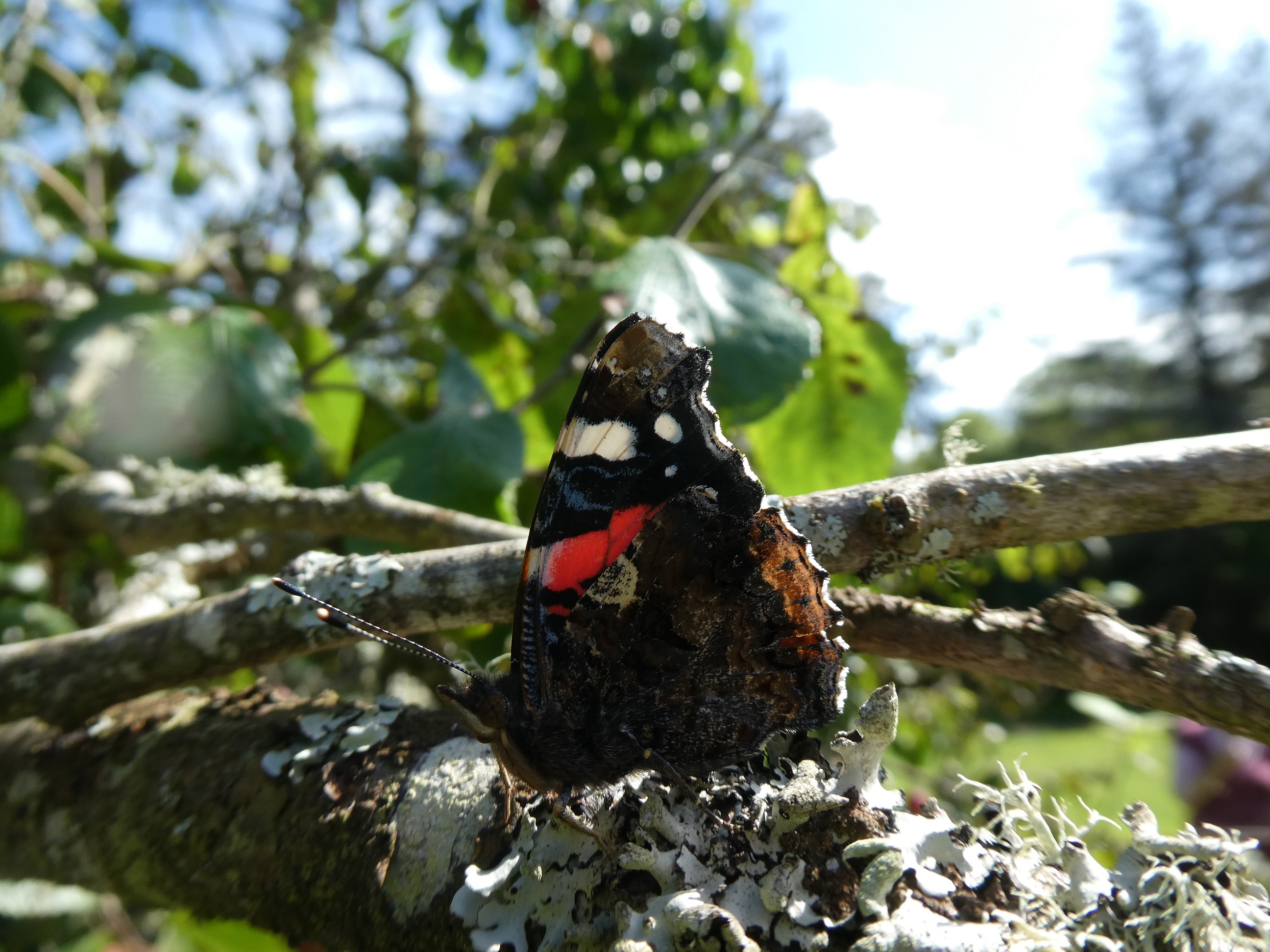
My East Meath garden stands on about half an acre of ground. My philosophy is to use native plants to build habitats found in the wild. This means squeezing in a meadow, wetland, pond, woodland, scrub, hedge and limestone grassland so that the site is fairly diverse if somewhat over-planted. Despite the purist emphasis on native species, I have a couple of beeches, grown as part of the hedge, a cultivated apple, Buddleia and Verbena but all these species have a value. If growing non-natives please ensure these do not escape and invade the countryside where they can do great harm. I have most of the native Irish trees which I grew from seed. For example, I collected acorns from sources that are the most likely to hold an original stock of Irish oak to preserve the indigenous genetic identity of these plants.
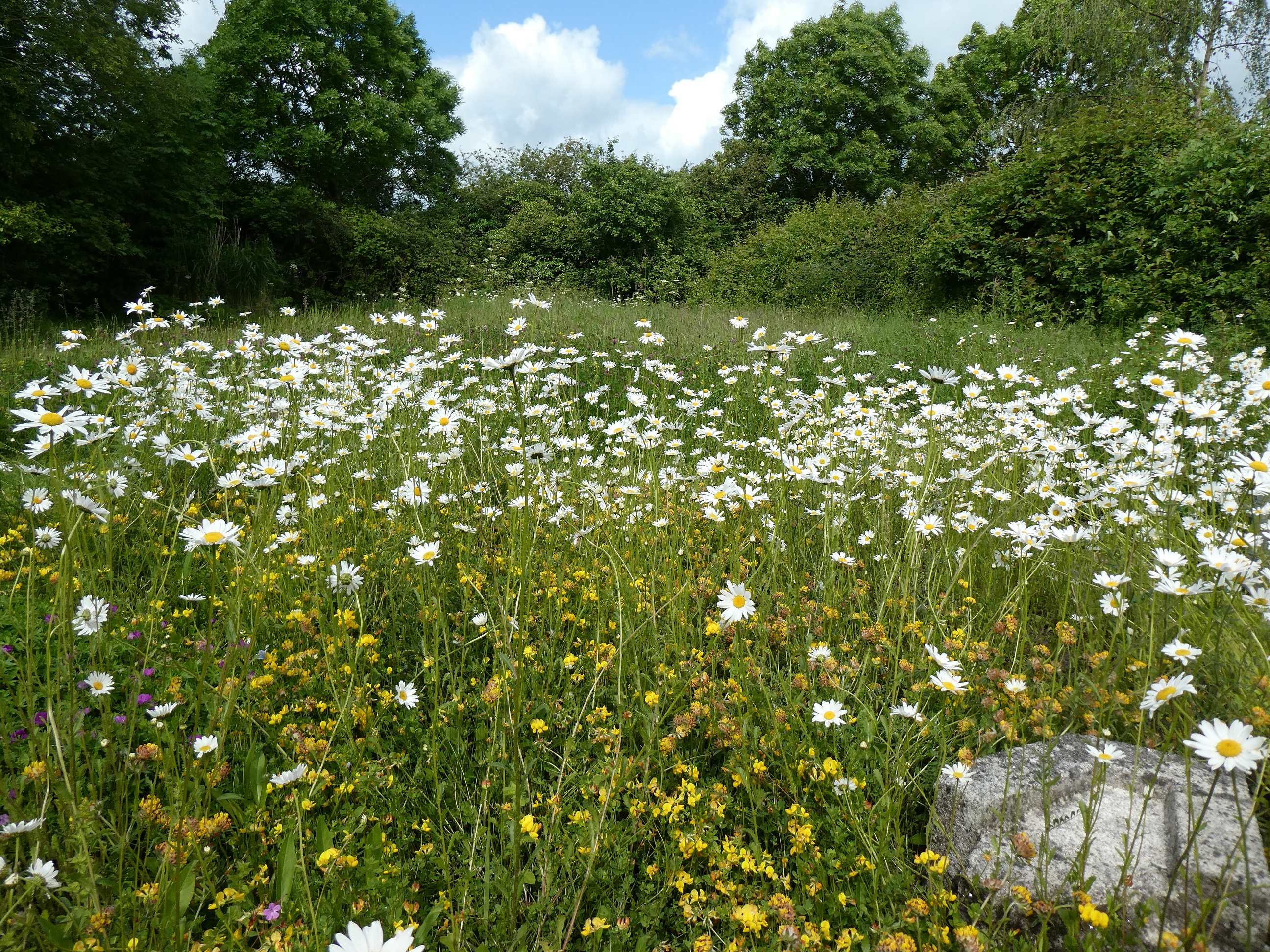
My meadow is chiefly a summer and early autumn flowering grassland, chiefly reliant on Common Knapweed and Devil’s-bit Scabious for colour, pollen and nectar. The meadow is uncut from a date in May until a date in September, with mowing dates, decided according to the season. All cuttings are removed to the compost heap to maintain the low fertility needed to prevent dense grass growth. Sowing Yellow Rattle and Red Bartsia helps thin out the grasses too! I have had over half of our native butterflies visit the garden and most of these have bred! It really enhances your chances of your butterflies breeding in your garden if, plant wise, you go native!
Some wild gardens are in their infancy. Building the garden and watching what turns up is really intriguing. Here Richella Duggan whose garden is in Mullingar talks about her experience.
“My garden isn’t very remarkable and has had very low numbers this year. I have Buddleia, Hebe, Cotoneaster, Common Holly, Alder Buckthorn and small amounts of nettles. Not much in the way of wildflowers but I do have Lesser Celandine and dandelions early in the year and later on lots of White Clover and self-heal. This autumn I’ll be sowing Common Knapweed, Yellow Rattle and Field Scabious so that I have some later-summer flowers next year. I get quite a few bees – Common Carder and Buff-tailed mostly but sometimes Red-tailed. I leave the grass long at the side of the house all summer and there is a Common Carder bumblebee nest in it for the first time this summer – which I was pleased with.”
A final garden to profile is Pat Bell’s remarkable plot in Maynooth, County Kildare. Pat has really pulled out the stops for butterflies in his back and front garden. Although compact, Pat makes incredible use of the space and gets big numbers in his garden. Native planting is the main framework of the garden, with natives like Gorse, Alder Buckthorn and Common Hawthorn forming hedging. The herb borders in the front garden combined with the Buddleia get lots of attention from a range of butterflies, including the Comma which is currently enjoying Pat’s hospitality. What is perhaps most striking is Pat’s ‘Butterfly Table’. Butterfly food is laid out on a marble-topped table and the butterflies and moths come to feed, in stunning numbers. Fig fruit, when ripe, is placed there and the colourful species, like the Comma and Red Admiral, sit happily feeding away. One can simply sit back and enjoy the antics-its like a bird table.
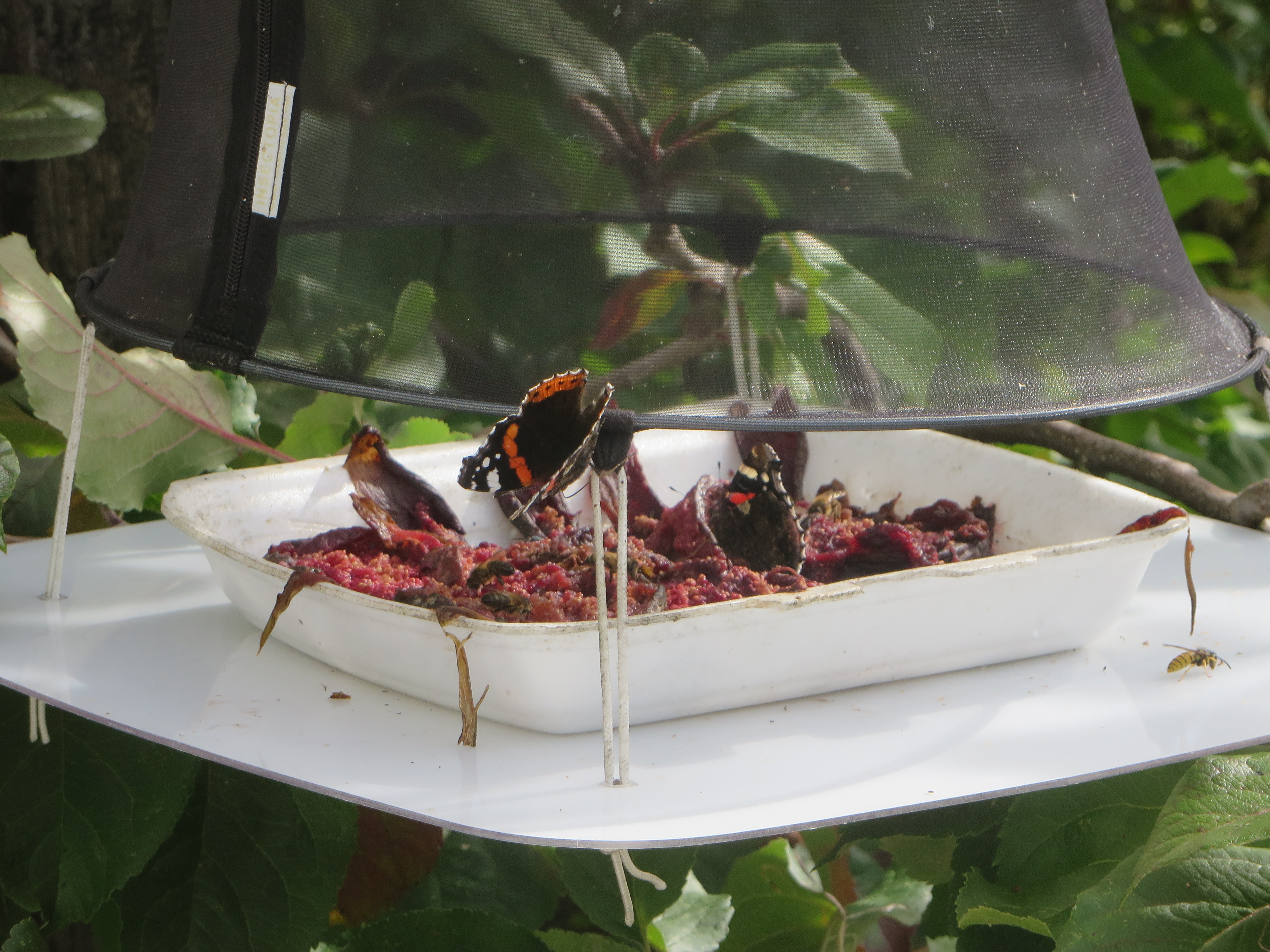
What is happening to parts of the natural world beyond our gardens is shocking. We are often left feeling helpless even after we make ourselves feel a little better after signing an online petition. But as the gardens profiled here show you can make a real difference in your garden. If all of us grew native flowers, trees and shrubs in our gardens our butterflies, moths, dragonflies, bees are among the vast range of invertebrates that can be given a home. These in turn feed frogs, newts, birds, bats. A great enrichment will follow. Then we will want to extend these habitats into the green spaces in our estates, villages, towns and cities. These developments are already happening in some places but there is so much that can be done to return the land to nature. We urge you to adopt the approach of our members who have shared their garden stories with you.
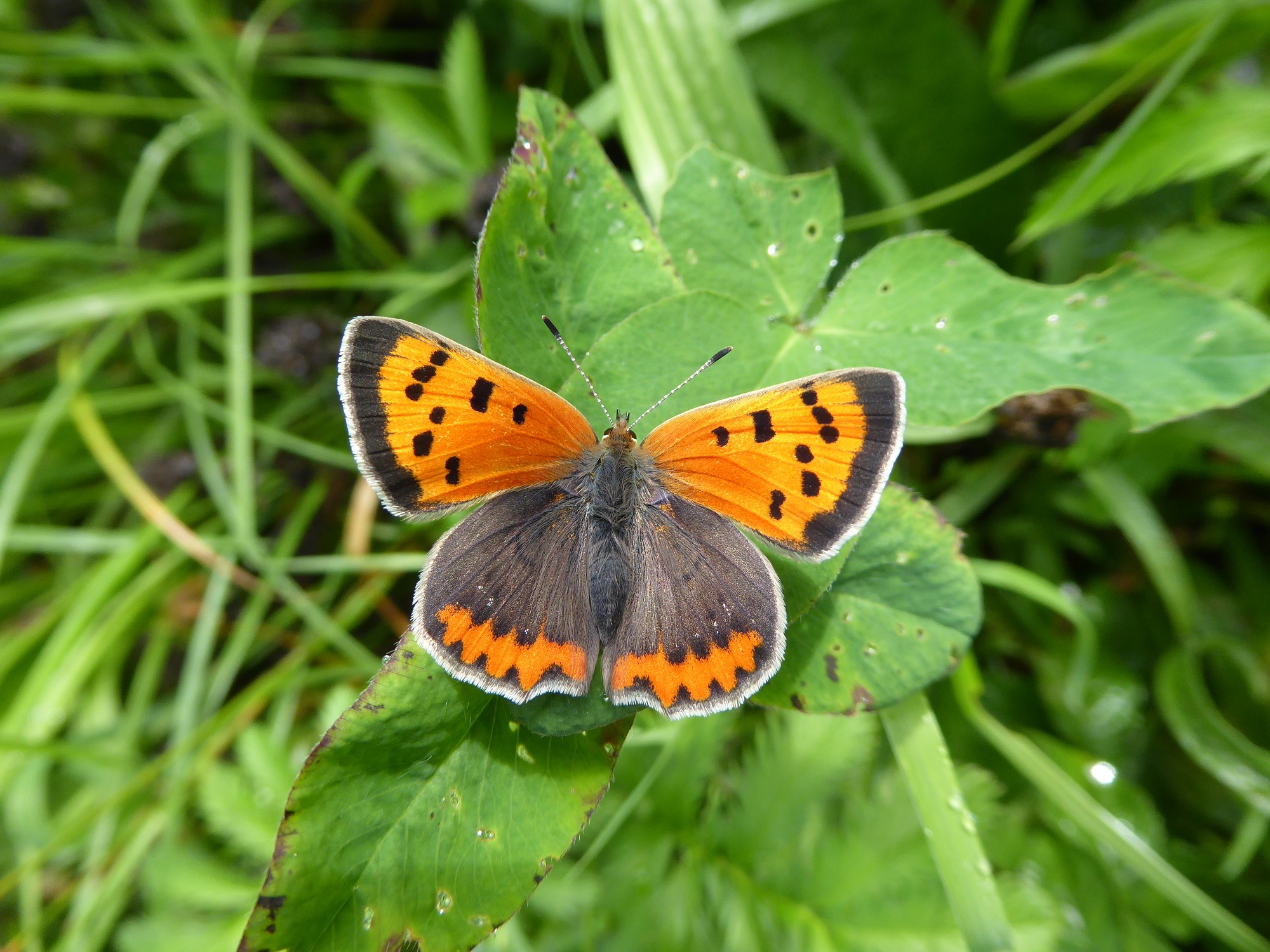
One of the really nice things about gardening like this is that you get to know your butterflies. Not only will you learn to identify the different species, but you will also observe their habits and manner. You will even get to know individual butterflies-some will stay in your garden for several weeks. A little idiosyncrasy or physical characteristic will help you recognise him or a her-a distinctive kink in a hindwing, a paler than usual hue, a little tear in a wing will aid recognition. You will follow his or her adventures over the days and weeks; you will find out which flower is his favourite, where he holds his territory, where his rival holds court; you will see battles between territorial species, some lengthy and ongoing. You may see courtship, mating, egg-laying. You might even find their caterpillars and eventually their pupae. Keep a notebook, take photos. Bond with your butterflies. These days, butterflies need us to be their friends.

